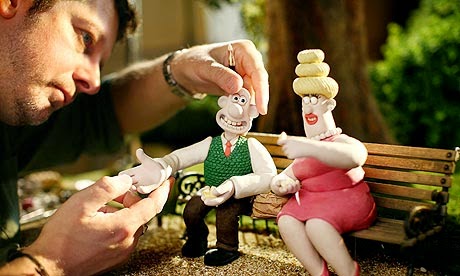Stop motion describes the process of making a sequence of pictures play in order at a speed which creates the illusion of movement. This is generally achievable by taking many photos of an object, through moving it slightly between each photo, creating an animation.
A well-known example of stop motion would be the famous 'Wallace and Gromit' animations. All the characters are made out of plasticine, and are therefore endlessly pose able. For every photo taken, parts of the characters are moved slightly. These individual photos are known as 'stop-frames'.
After the shooting, these stop-frames are all played quickly to create the illusion of real movement, much like the different frames that make up an animated cartoon.
History.
Stop motion is an animation technique to make a physically manipulated object or persona appear to move on its own. It is among the earliest forms of filmmaking.
It has a long history in film. It was often used to show objects moving as if by magic. The first instance of the technique can be credited to Albert E. Smith and J. Stuart Blackton for Vitagraph's 'The Humpty Dumpty Circus' (1897) in which a toy circus of acrobats and animals comes to life.
How quickly do the Stop-Frames change?
This partially comes down to personal preference. Ideally, a stop motion animation would hold 24 stop-frames within each second, though some may wish to attempt higher for smoother playback, or less with the price of more jagged animation.
The best way to create fluid animation is to use a high frame-rate with very little movement between each frame. If done correctly, it can breathe life into the characters.
Eadweard J. Muybridge.
Arguably one of the most important pioneers of 3D stop motion, Edward Muybridge was an English photographer of the 1800s; best known in the stop motion industry for his 'running horse' animation.
His initial goal was to prove the theory that a horse is airborne at least briefly during a gallop, which he accomplished in 1877 after successfully photographing such a point in the horses motion.
He proves his theory by taking several pictures of a horse running, placing them one after the other to create a moving image of a horse's gallop.
The Modern Stop Motion Industry
Whilst most animated films are not CGI, 3D stop motion is far from out the picture. Aardman Animations are still producing the children's television series 'Shaun the Sheep'.
Though Aardman Animations are well known in the stop motion industry, esteemed Director 'Tim Burton' has also created two animated 3D stop motion feature films. 'The Nightmare Before Christmas' and 'The Corpse Bride', the former of which is frequently looked back upon as a masterpiece in animation, and holds a cast cult following for its unique style and memorable characters.



No comments:
Post a Comment